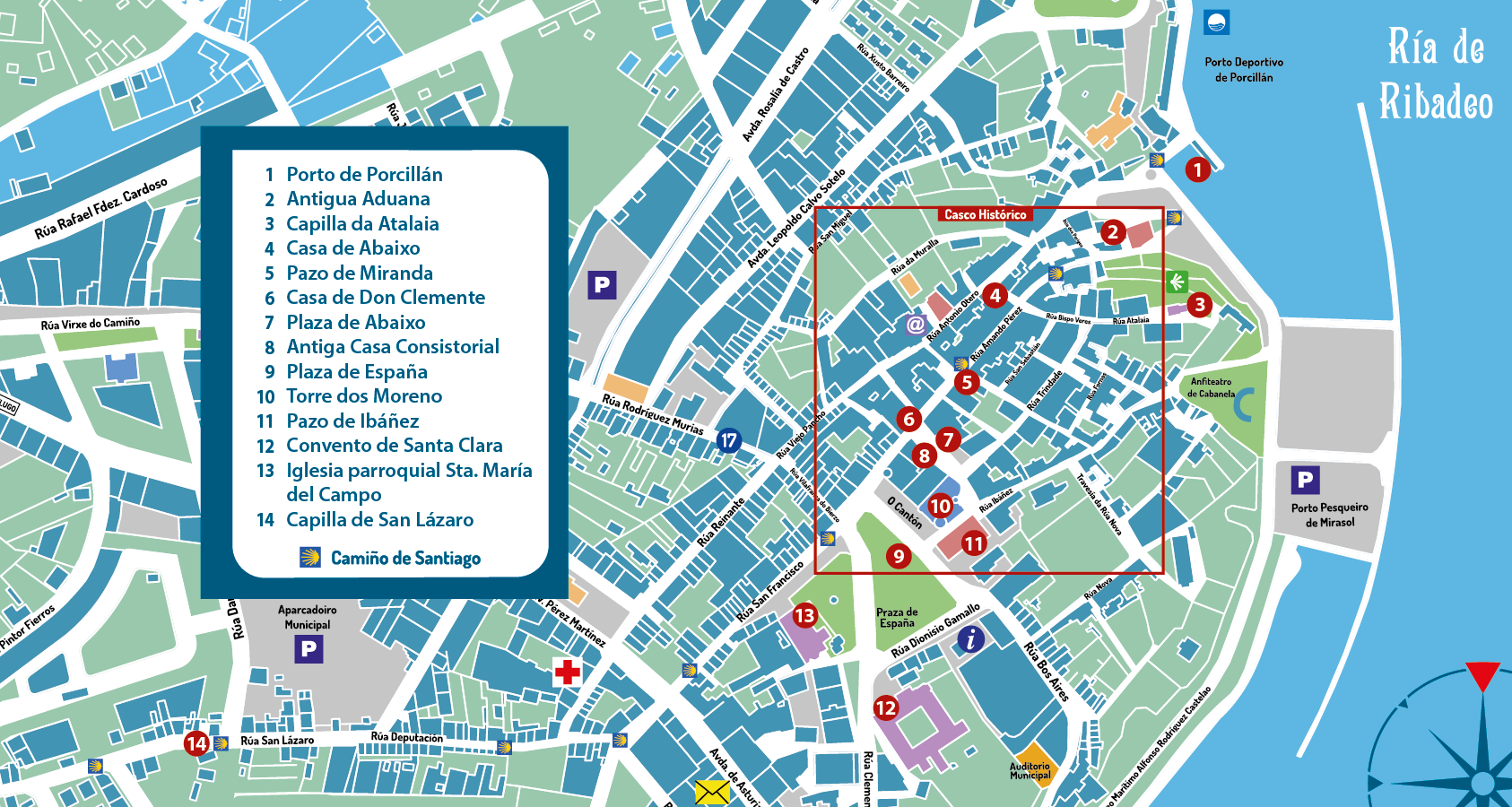Ribadeo
Beyond the Way
The Northern Way, declared a World Heritage Site by UNESCO, is together with the Primitive Way one of the routes of pilgrimage to Compostela with greater history and antiquity.
When the remains of the Apostle (9th century) are discovered, the cult of James begins strongly in the Astur-Galaic Kingdom and obtains, beyond the Pyrenees, a rapid popular response.
This would be the route used on numerous occasions by European kings and illustrious pilgrims such as San Francisco de Asís to reach Compostela, and although it lost prominence after the Reconquest and the empowerment of the French way by the monarchy of the 12th century, the persistence of pilgrimages managed to strengthen the route that would already be known as the coastal Way of Saint James.
Along the Way the pilgrim will cross bridges, Roman roads, thousand-year-old paths, will go through villages of very long Saint James tradition, full of hospitable people and, of course, incredible spaces. It involves walking along a route with twelve centuries of history and leaving behind habits and routines that today, as at the dawn of the pilgrimage, transforms those who experience it at least once in a lifetime.
This Saint James route in Galicia wanders along paths that are the secular setting around which the pilgrim finds an outstanding and differentiated architectural and ethnographic heritage from the rest of the Iberian Peninsula.
"The Northern Way is possibly one of the options that will give us a greater landscape beauty and involves enjoying innumerable landscapes full of contrasts."
Ribadeo
Gateway to Galicia
The Northern Way is a trade, culture and pilgrimage itinerary that leads to Santiago de Compostela by the north, having in Ribadeo one of its marked milestones. The faithful not only from Asturian lands but also from all over the north of the peninsula, and even from northern Europe arriving by sea to the Basque and Cantabrian ports from England, Flanders, Germany or Scandinavia, entered Galicia crossing the Cantabrian Sea through the beautiful ‘ría’ of Ribadeo.
Our historic town is the gateway and starting point of the Saint James route in Galicia. From here, 193.2 km separate the pilgrim from his longed-for destination, the Cathedral of Santiago.
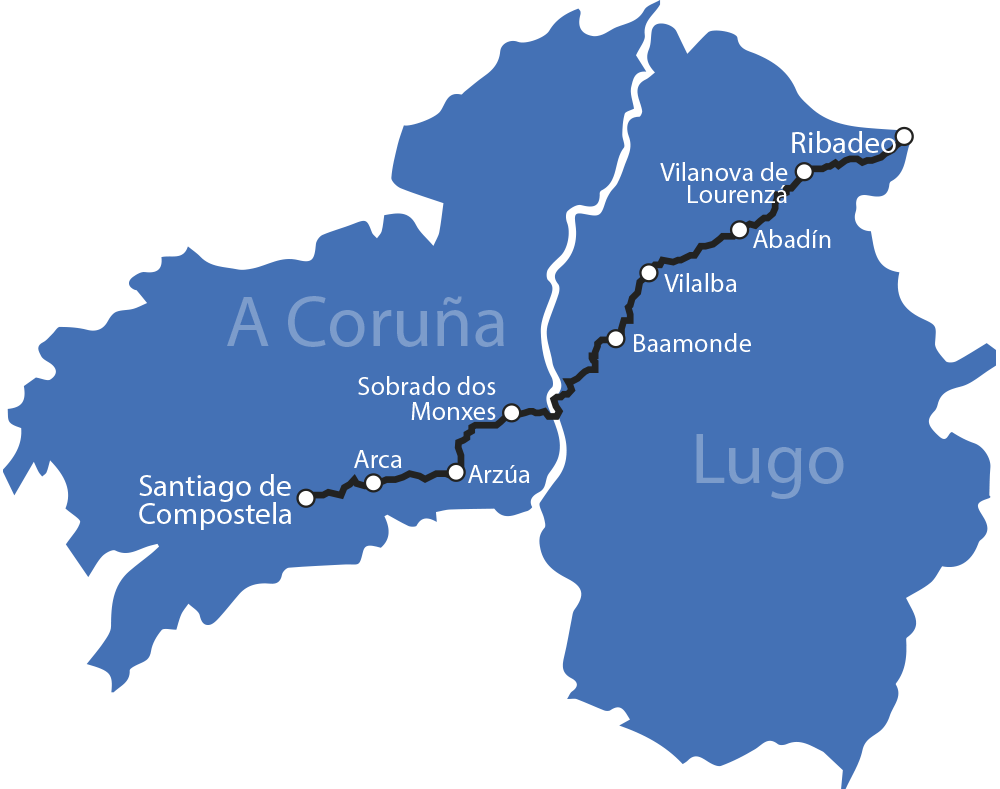
- Stage 1. Ribadeo – Vilanova de Lourenzá. 28 km
- Stage 2. Vilanova de Lourenzá - Abadín. 25 km
- Stage 3. Abadín - Vilalba. 20,3 km
- Stage 4. Vilalba - Baamonde. 19,1 km
- Satge 5. Baamonde - Sobrado dos Monxes. 40,3 km
- Stage 6. Sobrado dos Monxes - Arzúa. 21,9 km
- Stage 7. Arzúa - Arca (O Pino). 18,4 km
- Stage 8. Arca - Santiago de Compostela. 20,2 km
RibadeoXCamino
Pilgrims once they arrived at Castropol boarded to cross the ‘ría’ of Ribadeo and come into Galicia via Santiago de Vigo, the old “Ripa Euve”, Ribadeo at present. It is documented the existence of small boats from the Middle Ages in different places of the ‘ría’ that allowed the pilgrim to cross and disembark at the port of Porcillán, formerly known as Julian.
Today the ‘Puente dos Santos’ brings Asturias and Galicia closer, simplifying the entry into Galicia.
San Julián, nicknamed the Hospitable, is the patron saint of pilgrims, innkeepers and boatmen. Tradition tells that after he had killed his parents by mistake he became a boatman, helping travellers to cross a dangerous river and he even founded together with his wife a hospital to assist them on their journey. It is not known whether the reason for this initial denomination of the port is really an intention of linking the river in which San Julián worked as a boatman with the ‘ría’ of Ribadeo to promote the pilgrimage to Santiago through our town, but we do know the work carried out by the Bela couple.
Pedro Belo and his wife Maria Bela would found a pious boat that would donate together with a house to the Monastery of Sar and to the ecclesiastical authorities of Ribadeo, on condition that both communities kept in that house “a navigating man who on his boat carries and brings without burden and for free those passers-by to and from the port Julián, that is on Ribadeo”. Thus, in 1206 the construction of the ‘Hospital da Barca’ would be started but we do not know how long it lasted. It was supposed to favour the people passing through from Galicia to Asturias from all points of Europe who came to visit the sepulchre of the Apostle Santiago.
Nowadays the most visited and international places of Galicia are Compostela with its cathedral, work summit of universal art, and the beach of As Catedrais where the powerful waters of the Cantabrian carved, over the centuries, what at present it can be seen as a whimsicality of nature. The rocks surprise because they look more like a scenery, meticulously drawn, than a sequence of caves, passages and arches, becoming one of the most beautiful beaches in the world.
These two resources are part of an important nexus of great value and richness and they join together in a journey in which any traveler who wants to take a magical image of Galicia should not give up visiting them to be amazed by the power of creation of nature and the human being.
For the pilgrim who begins his tour in Ribadeo, the beach of As Catedrais is an essential visit to gather strength before entering the mystical Galicia and leave behind the saltpetre smell of the Cantabrian.
From the natural cathedral to the spiritual cathedral
Worldwide known as the beach of As Catedrais, its original name is ‘Playa de Augas Santas’ with reference to the healing powers of its waters. Many people from the inland province, as a ritual at the end of summer, came for a bathe for blood tonic and healing purposes, since these waters have a large quantity of iodine with a regenerative function for the skin and to strengthen the defenses thanks to its antibiotic, anti-inflammatory, moisturizing and mineralizing properties.
The Northern Route works as a unifying axis between these two cathedrals, allowing the traveller to enjoy this great natural and cultural richness.
The beach of As Catedrais, a natural monument of supernatural dimensions, will surprise pilgrims who branch off a few kilometres to know it. You just have to wait for the low tide, take off your shoes, begin to walk…
Route of the Saint James Way
The stage by the lands of Ribadeo is a stretch of about 16 km. It starts at the port from where the pilgrim will go up by the Amando Pérez street, formerly High Street, towards the old town, which stands in a natural vantage point from where you descrythe beauty of the ‘ría’ that gives it its name, and go into its important medieval and modern architectural complex.
Wandering about its enlightened route allows the traveller to go into a unique urban trace, product of the economic peak experienced in the 18th century at the hand of sea trade, when distinguished local and foreign traders attracted by this commercial splendor will promote the construction of new houses contributing to the transformation of the town, its infrastructures, streets and architecture, providing a typical character and spirit, unique in Galicia.
On the way up, the traveller leaves behind the building of the old Customs with its beautiful north-facing façade, ‘pazo’ built in 1726 that would be the headquarters of customs, becoming the third one in terms of collection volume within the old Kingdom of Galicia, only surpassed by the Customs of A Coruña and Ferrol. Its spacious ground floor worked as warehouses and salt warehouse.
Ascending through the main street of the village during the 18th century, the pilgrim will move forward among a large number of traditional houses, either humble, one-storey, or others of greater appearance. The most noteworthy, for being property of important traders of the town, are the ‘Casa de Abaixo’, built by Francisco Antonio de Bengoechea, a trader of Basque origin, where he will establish the Bengoechea banking and trade house, devoted to commercial, shipping and bank activity, at the beginning of the 19th century; or the ‘pazo’ that belonged to the Miranda and shows their arms. Its first owner was Mr. Pedro de Miranda Osorio, knight of Santiago, who got rich in the 18th century with the trade of timber.
Further up the street, and when we see at the back the trees of the Plaza de España, the nerve center of the town at present, the beautiful Don Clemente’s house attracts attention with its balconies and galleries, bringing the pilgrim closer to a new key element to know the idiosyncrasy of Ribadeo. Emigration to America and the important mark left by the returned emigrants, the ‘indianos’, make Ribadeo the Galician municipality with the highest rate of ‘indiano’ houses.
Opposite the Don Clemente’s house, the Plaza de Abaixo, the old main square of the town and nerve center of citizen coexistence until the 19th century, opens to the traveller. Nowadays wonderful buildings that reflect the history of the villa on their façades. The Moreno’s Tower, the old town hall, the Colón cinema and magnificent houses with balconies and galleries from the late 19th and early 20th centuries.
Finished the way up, the Way arrives at the Plaza de España, whose historical name is Plaza del Campo, because it was placed outside the old walls of the town and when the poplar grove did not yet exist. Constructions that allow to go round the history of Ribadeo are risen around this square, like the neoclassical ‘pazo’ of Ibáñez, the Moreno’s Tower, the Santa Clara convent or the Santa María del Campo parish church.
A must-see for the pilgrim, the Santa María del Campo parish church was part of the former franciscan monastery founded, according to tradition, by Francisco de Asís during his pilgrimage to Compostela in 1214, arriving here as Ribadeo was episcopal see at the time.
Little remains of the medieval temple converted into parish with the name of Santa María del Campo church after the Mendizábal’s confiscation. Nowadays, it has three vaulted naves and a special chapel, where the entrance to the former chapter hall is masked.
In the nearby Villafranca del Bierzo street there was a hospital for pilgrims that gives evidence of Ribadeo being a hospitable town since the 12th century, the San Sebastián Hospital. Many documents compile that the hospice welcomed “the poor, pilgrims, passers-by and the sick”. In 1550 the hospice had 20 beds and “shelter was given to pilgrims only for 24 hours in the ground floor stables providing them with firewood to make a fire, straw to lie down and a local blanket to cover”.
In 1766 it merged with the San Lázaro hospital, it permanently disappeared in 1857, already turned into a charity hospital de caridad y assistance centre.
The Way leaves the old town by the San Francisco street heading for the San Lázaro chapel. It is in the district of the same name, at the foot of the former Camino Real that led to Mondoñedo, nowadays it is an obligatory step for pilgrims who take the way towards Santiago. That is all that remains from the former hospital with the same name that existed from the 14th century to look after leprosy patients.
The chapel, like the hospital, was always very humble. In the left door, kept behind bars, there is a small altar with the image of San Lázaro, patron saint of lepers and the poor. That is why hospitals in general, especially those for infectious, and more often those for lepers, were called “lazaretos”.
From here, the Way continues along an ancient route, perhaps Roman or late Roman, which was also the main access road to the Galician interior and the ancient capital of Mondoñedo, and will take us to Vilanova de Lourenzá.
The Way of Saint James across Ribadeo passes through a territory that largely preserves the traditional way of life, which allows the identification on the ground of a cultural landscape from a historical, architectural, archaeological and ethnographic point of view, besides the inmaterial values as depositories of the preserved traditional activities and customs.
The pilgrim will pass the parishes of Ove, where the ancient order of the Hospitable Knights had one of its houses depending on the Portomarín Hospital, Covelas and Arante. At the last one, on the district of A Ponte, the visit to the Sanctuary of Nuestra Señora de las Virtudes is a must.
It is a very worshiped and visited sanctuary by the faithful due to the miraculous fame of its virgin. The origin of this temple dates from the end of the 14th century, although it was refurbished in the following centuries. On the altar a Renaissance altarpiece is preserved with the images of Nuestra Señora de las Virtudes and a Santiago Matamoros.
This temple preserves a valuable heritage in late medieval mural paintings, and also a singular votive offering painted that relates the miraculous intercession of the Virgin in favour of the ship Santa Catalina, in 1595.
The relation between the place of A Ponte and the Saint James Way goes back a long way, because from the 14th century there was here a hospital, dedicated to San Andrés, for the poor and pilgrims. They could receive free of charge accommodation, a bed, light and firewood. The pilgrims could only stay one night, the person responsible for welcoming them was the hospitaller, who also had to make the beds, the meals, to wash the clothes and to build and provide a fire to those pilgrims.
In 1834 a big flood destroyed the hospital building and the contiguous San Andrés chapel with its images, the hospital activity disappeared then in A Ponte.
Discover Ribadeo
Highlights
The places you cannot miss on the Way through Ribadeo.
 Port of Ribadeo
Port of Ribadeo Old Customs
Old Customs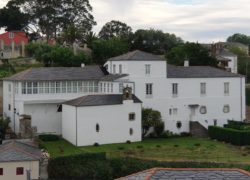 Pazo de Guimarán
Pazo de Guimarán Atalaia
Atalaia Casa de Abaixo
Casa de Abaixo Casa dos Miranda
Casa dos Miranda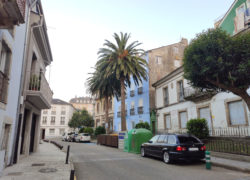 Praza de Abaixo
Praza de Abaixo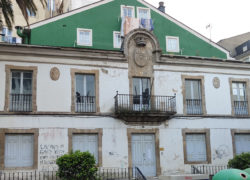 Former Town Hall
Former Town Hall Praza de España
Praza de España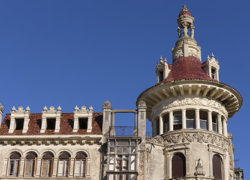 Moreno’s Tower
Moreno’s Tower Pazo de Ibáñez
Pazo de Ibáñez Santa Clara Convent
Santa Clara Convent Santa María del Campo parish church
Santa María del Campo parish church San Lázaro chapel
San Lázaro chapel San Xoán de Ove parish church
San Xoán de Ove parish church O Valín
O Valín Capilla del Carmen en Vilela
Capilla del Carmen en Vilela San Vicente de Covelas parish church
San Vicente de Covelas parish church The place of A Ponte (Arante)
The place of A Ponte (Arante)
Why Ribadeo?
Because there is a natural, cultural, lively and close Ribadeo.

